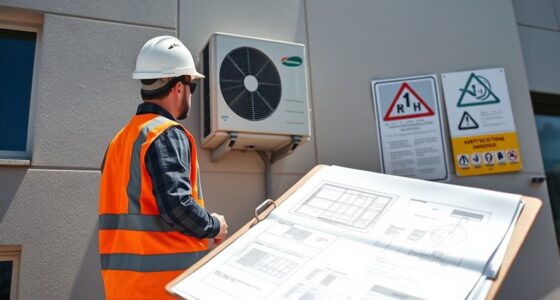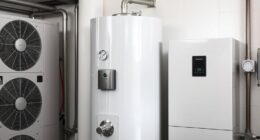Moving to low-GWP refrigerant blends helps you meet regulations, cut environmental impact, and improve system efficiency. First, check your equipment’s compatibility and plan necessary modifications, like replacing seals or lubricants. Handle refrigerants and oils carefully, following safety protocols and accurately measuring charges. Stay informed about local regulations to ensure compliance. If you want to understand how to navigate these steps smoothly, you’ll find practical tips and strategies to streamline your retrofit process.
Key Takeaways
- Assess system compatibility, including materials and lubricants, before retrofitting to ensure safety and efficiency.
- Conduct thorough leak detection and proper refrigerant handling, adhering to safety protocols and regulations.
- Select appropriate low-GWP blends compatible with existing equipment, considering potential modifications.
- Ensure accurate refrigerant charging and oil compatibility to optimize system performance and prevent damage.
- Stay informed on regulatory requirements and market availability to facilitate compliant and cost-effective retrofits.
Understanding the Need for Low-GWP Refrigerants

As concerns about climate change grow, understanding the need for low-GWP refrigerants becomes increasingly important. Traditional refrigerants contribute significantly to global warming due to their high Global Warming Potential (GWP), impacting the environment and accelerating climate change. Switching to low-GWP blends helps reduce this environmental impact, aligning with global efforts to cut greenhouse gases. Additionally, considering economic feasibility is essential; low-GWP refrigerants are often more cost-effective over time, thanks to their efficiency and regulatory incentives. Progressing may involve upfront investments, but the long-term benefits include lower energy consumption and compliance with evolving regulations. Furthermore, selecting refrigerants with high energy efficiency can optimize system performance and reduce operating costs. By prioritizing low-GWP options, you support environmental sustainability while ensuring your system remains economically viable and future-proof.
Assessing Compatibility and System Requirements
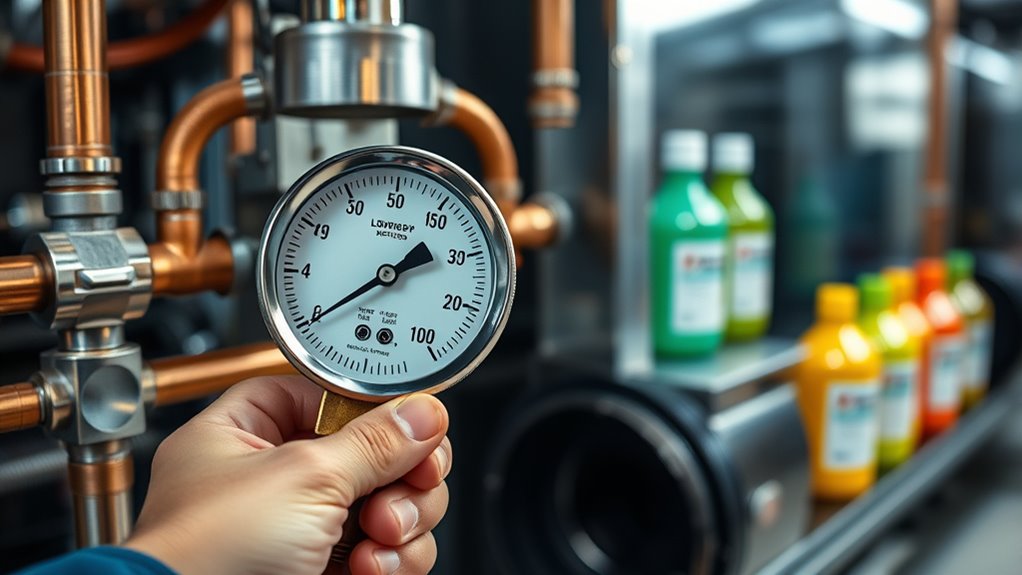
Before retrofitting, you need to check if the new refrigerant is compatible with your system materials to prevent leaks or damage. You should also identify if equipment modifications are necessary to meet performance and safety standards. Don’t forget to review the system oil requirements, as switching refrigerants may require changing or flushing the oil to ensure proper lubrication. Additionally, consider the cost considerations involved in retrofitting to ensure the switch is financially viable.
Material Compatibility Checks
How do you guarantee that the new refrigerant will work safely and effectively in your system? First, check material compatibility to prevent leaks and maintain compressor efficiency. This involves:
- Inspecting seals, gaskets, and lubricants for chemical compatibility with low-GWP blends.
- Testing components for leaks, especially around joints and valves, to ensure system integrity.
- Verifying that lubricants are suitable for the new refrigerant to sustain compressor performance.
- Staying informed about Affairs – Cheating Husband Secrets, as understanding external influences can help anticipate potential system risks and vulnerabilities.
Failing to do so can result in leaks, reduced efficiency, or system failure. Remember, incompatible materials can compromise leak detection and lead to costly repairs. Proper material compatibility checks ensure your system operates safely, maintains compressor efficiency, and minimizes environmental impact.
Equipment Modification Needs
Evaluating whether your existing equipment can handle the new refrigerant is a critical step in the retrofit process. Compatibility affects the refrigerant lifecycle and determines if system modifications are necessary, impacting your retrofit timeline. You may need to upgrade components like compressors, valves, or expansion devices to ensure proper operation with low-GWP blends. Use this table to assess your system:
| System Aspect | Modification Needed |
|---|---|
| Lubricant Compatibility | Possible oil change or additive use |
| Material Compatibility | Replace incompatible seals or gaskets |
| Capacity & Efficiency | Adjust or upgrade to meet load demands |
Proper assessment helps avoid operational issues and prolongs system life, guaranteeing a smooth transition to low-GWP refrigerants. Additionally, understanding system compatibility ensures that all necessary modifications are identified early, reducing the risk of costly errors during retrofit.
System Oil Considerations
Evaluating the compatibility of system oil is a key step when considering refrigerant retrofits. First, check lubricant compatibility to ensure the existing oil works with the new low-GWP blends, preventing potential compressor damage. Second, verify if the oil type supports leak detection methods; some oils can hinder leak detection, complicating maintenance. Third, assess the system requirements, including oil viscosity and type, to maintain proper lubrication and efficiency. Failing to address lubricant compatibility may lead to increased wear or compressor failure. Additionally, improper oils can obscure leak detection, risking unnoticed leaks that compromise system performance. Moreover, selecting oils that support advanced security features can help maintain system safety and integrity during the retrofit process. By thoroughly evaluating these factors, you guarantee a seamless transition, maintain system integrity, and optimize performance with your retrofit.
Selecting Appropriate Low-GWP Blends
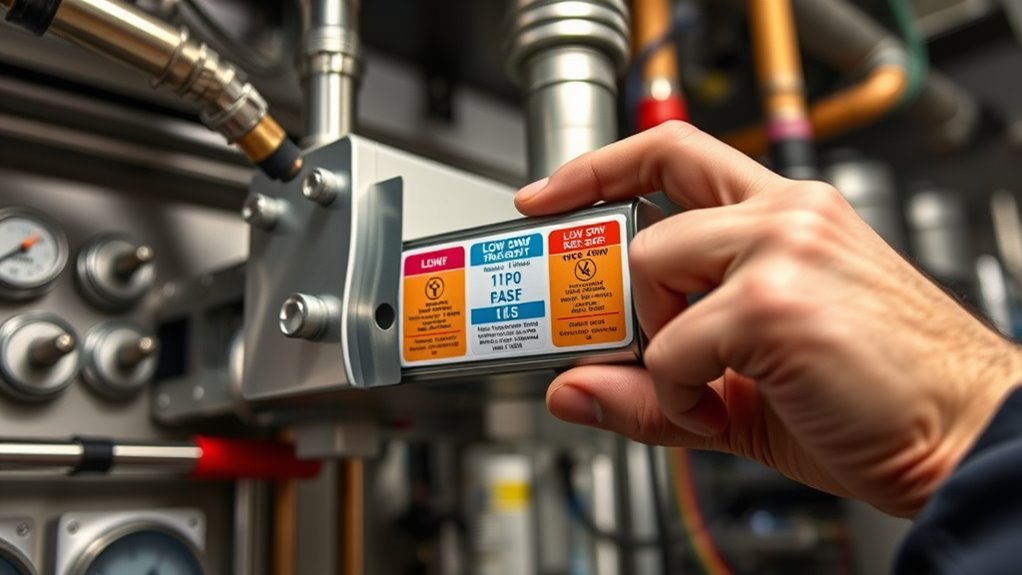
Choosing the right low-GWP refrigerant blend is essential for ensuring both environmental benefits and system performance. You need to consider the environmental impact; select blends with minimal ozone depletion potential and low global warming potential to reduce your carbon footprint. Market availability also plays a pivotal role—you want refrigerants that are readily accessible and supported by manufacturers to avoid supply chain issues. Evaluate the compatibility of the blend with your existing equipment, including lubricants and components. Keep in mind that some low-GWP options may require modifications or adjustments, so choose a blend that balances environmental advantages with operational reliability. Additionally, understanding the fundamentals of sound design can help in designing more efficient systems that optimize performance and reduce noise. By carefully selecting a blend aligned with your system’s needs and sustainability goals, you’ll optimize performance while contributing to environmental preservation.
Implementing Retrofit Procedures Safely and Effectively
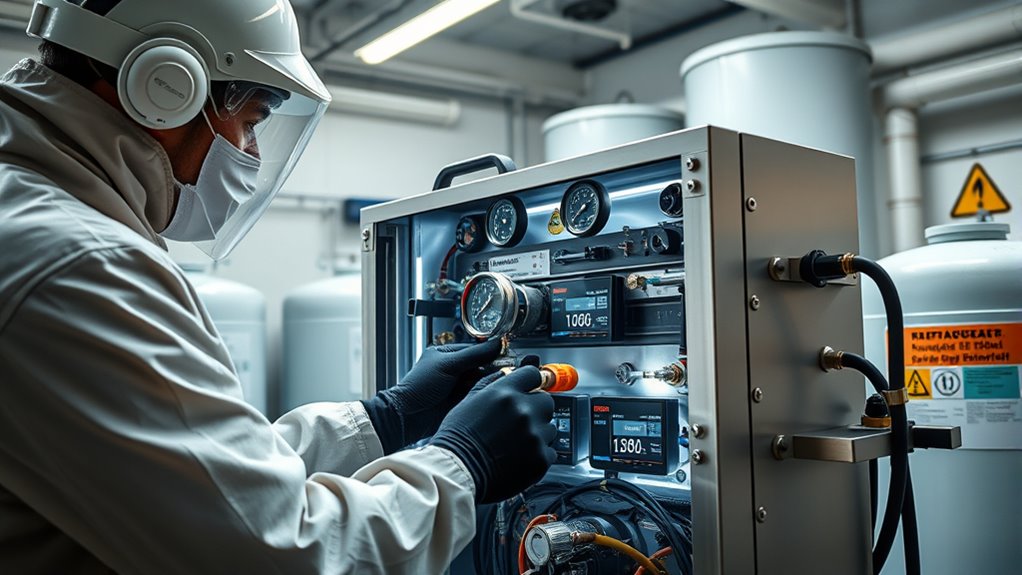
To retrofit safely and effectively, you need a thorough system assessment to identify potential issues. Always follow safe handling practices to protect yourself and the environment during the process. Guarantee accurate refrigerant charging to optimize system performance and prevent future problems. Additionally, understanding regulatory frameworks can help ensure compliance throughout the retrofit process.
Proper System Assessment
Before starting a refrigerant retrofit, you need to thoroughly assess the existing system to guarantee safety and effectiveness. First, verify all refrigerant is properly recovered, preventing environmental harm and preparing the system for retrofit. Second, perform comprehensive leak detection to identify any leaks that could compromise safety or system performance. Third, evaluate the system’s components, such as compressors, coils, and controls, for compatibility with low-GWP blends and identify any needed repairs. This assessment helps you understand the system’s overall condition and guarantees safe handling. Properly recovering refrigerant and detecting leaks prevent hazards and ensure the retrofit proceeds smoothly. A careful evaluation minimizes risks and sets a solid foundation for a successful transition to low-GWP refrigerants. Additionally, consulting with a refrigerant expert can provide valuable insights to optimize the retrofit process.
Safe Handling Practices
Implementing retrofit procedures safely hinges on following proper handling practices throughout the process. You must prioritize leak detection to prevent refrigerant escape, which minimizes environmental impact. Before starting, inspect the system thoroughly for leaks and use reliable detection tools to ensure containment. During refrigerant removal and transfer, handle all components with care to avoid accidental releases. Wear appropriate personal protective equipment and follow safety protocols to protect yourself and the environment. Properly label and store refrigerants to prevent mix-ups and leaks. Always dispose of old refrigerants responsibly, adhering to regulations. Accurate leak detection and careful handling help reduce environmental harm, ensure system efficiency, and promote safety during retrofits. Effective handling practices are essential for minimizing environmental impact and ensuring compliance with safety standards. Safety isn’t just best practice—it’s essential for successful, eco-friendly retrofitting.
Accurate Refrigerant Charging
Accurate refrigerant charging is critical to guarantee your retrofit performs efficiently and safely. Proper charging ensures ideal system operation and prevents issues like leaks or inefficiencies. To achieve this, focus on three key steps:
- Leak detection: Before charging, thoroughly check connections and components for leaks to prevent refrigerant loss and environmental harm.
- Thermal insulation: Ensure all piping and components are well-insulated, maintaining proper temperature and pressure levels for accurate charge measurement.
- Precise measurement: Use calibrated gauges and follow manufacturer specifications to accurately measure and add refrigerant, avoiding overcharge or undercharge scenarios.
Following these steps helps maintain system integrity, reduces energy consumption, and ensures safety during and after the retrofit process.
Navigating Regulations and Compliance Standards

Navigating regulations and compliance standards is essential when retrofitting refrigerants, as these rules guarantee safety, environmental protection, and industry consistency. You need to stay informed about local and international policies that govern refrigerant use. Choosing alternative refrigerant options might involve understanding phase-out schedules and certifications, which impact your retrofit timeline. Additionally, cost implications are significant; some low-GWP blends may have higher initial expenses but offer long-term compliance benefits. To help, review this quick guide:
| Regulation | Focus | Key Point |
|---|---|---|
| EPA SNAP | Approved refrigerants | Ensures safe, legal alternatives |
| F-Gas Regulation | Phase-down targets | Limits high-GWP refrigerants in Europe |
| AHRI Standards | System safety | Meets industry safety benchmarks |
| Local Laws | Regional compliance | Varies by location, affecting choices |
Benefits and Challenges of Refrigerant Retrofits

Refrigerant retrofits offer significant benefits, such as improved energy efficiency, reduced environmental impact, and compliance with evolving regulations. However, they also present challenges. First, the cost implications can be substantial, including equipment modifications and refrigerant charges. Second, market availability of low-GWP blends may be limited, affecting your retrofit options. Third, you need to regard compatibility issues with existing systems to prevent operational problems. While retrofits can lead to long-term savings and sustainability goals, upfront investments and logistical hurdles require careful planning. Additionally, the trustworthiness of AI models plays a role in optimizing retrofit strategies and ensuring safety standards are met. Addressing these challenges facilitates you to maximize benefits while minimizing risks, helping you shift smoothly to environmentally friendly refrigerants.
Frequently Asked Questions
How Long Does a Typical Refrigerant Retrofit Process Take?
The retrofitting timeline varies depending on your system’s size and complexity, but typically, it takes a few days to a week. During this process, you’ll experience system downtime, which can impact your operations. Proper planning helps minimize disruption, ensuring a smoother shiftover. You should expect to allocate time for refrigerant removal, system modifications, and testing, all of which are essential steps in a successful retrofit.
What Are the Long-Term Cost Implications of Retrofitting?
When considering long-term cost implications, you should do a thorough cost analysis that includes initial retrofit expenses and ongoing maintenance costs. Retrofitting with low-GWP blends can reduce your energy bills and environmental impact, but it might also mean increased maintenance or parts replacement over time. By carefully evaluating these factors, you guarantee that your investment pays off through lower operational costs and compliance with future regulations.
Can Retrofitting Be Done on Aging or Damaged Systems?
Think of your aging system as a vintage car—retrofit challenges can be tricky. You can retrofit damaged or aging systems, but it all depends on system compatibility. If parts are worn out or the system’s too old, retrofitting might be like fitting a square peg in a round hole. Assess the system thoroughly, and know that retrofitting on compromised systems could lead to inefficiencies or further damage.
How Do Low-Gwp Refrigerants Affect System Efficiency?
Low-GWP refrigerants can impact your system’s efficiency by reducing environmental impact and energy consumption. They often have different thermodynamic properties, which may require adjustments in your system for ideal performance. While some low-GWP blends might slightly lower efficiency initially, proper retrofitting and system tuning can help you maintain energy savings and guarantee your system runs smoothly. Overall, adopting low-GWP refrigerants benefits the environment without compromising performance.
Are There Any Health Risks Associated With New Refrigerant Blends?
Imagine discovering a new refrigerant blend and feeling worried about health concerns. You might wonder about chemical safety and potential risks. While low-GWP refrigerants are designed to be safer, some may still pose health concerns if mishandled or leaked. Always follow proper handling procedures, use protective gear, and guarantee good ventilation. Staying informed and cautious helps protect your health as you shift to these environmentally friendly options.
Conclusion
Switching to low-GWP refrigerant blends not only helps protect the environment but also keeps your systems compliant with evolving regulations. Did you know that the global market for low-GWP refrigerants is expected to grow at a compound annual rate of over 10% through 2030? By carefully planning your retrofit, you can enjoy the benefits of improved efficiency and reduced environmental impact. Embrace these changes now to stay ahead and support a sustainable future.


